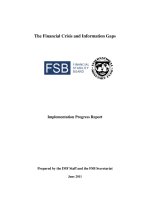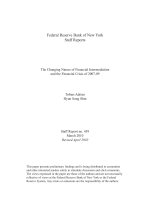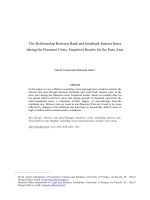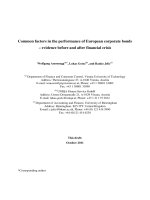posta & talani (eds.) - europe and the financial crisis (2011)
Bạn đang xem bản rút gọn của tài liệu. Xem và tải ngay bản đầy đủ của tài liệu tại đây (3.11 MB, 299 trang )
Europe and the Financial Crisis
9780230285545_01_prexvi.indd i9780230285545_01_prexvi.indd i 3/21/2011 6:43:29 PM3/21/2011 6:43:29 PM
Also by Pompeo Della Posta and published by Palgrave Macmillan
GLOBALIZATION, DEVELOPMENT AND INTEGRATION: A European
Perspective (co-editor)
Also by Leila Simona Talani and published by Palgrave Macmillan
THE FUTURE OF THE CITY OF LONDON
THE GLOBAL CRASH (editor)
THE FUTURE OF THE EMU (editor)
9780230285545_01_prexvi.indd ii9780230285545_01_prexvi.indd ii 3/21/2011 6:43:29 PM3/21/2011 6:43:29 PM
Europe and the
Financial Crisis
Edited by
Pompeo Della Posta
Associate Professor in Economic Policy, University of Pisa, Italy
and
Leila Simona Talani
Associate Professor (Reader) in International Political Economy,
King’s College London, UK
9780230285545_01_prexvi.indd iii9780230285545_01_prexvi.indd iii 3/21/2011 6:43:29 PM3/21/2011 6:43:29 PM
Selection and editorial matter © Pompeo Della Posta and
Leila Simona Talani 2011
Individual chapters © contributors 2011
All rights reserved. No reproduction, copy or transmission of this
publication may be made without written permission.
No portion of this publication may be reproduced, copied or transmitted
save with written permission or in accordance with the provisions of the
Copyright, Designs and Patents Act 1988, or under the terms of any licence
permitting limited copying issued by the Copyright Licensing Agency,
Saffron House, 6–10 Kirby Street, London EC1N 8TS.
Any person who does any unauthorized act in relation to this publication
may be liable to criminal prosecution and civil claims for damages.
The authors have asserted their rights to be identified as the authors of this
work in accordance with the Copyright, Designs and Patents Act 1988.
First published 2011 by
PALGRAVE MACMILLAN
Palgrave Macmillan in the UK is an imprint of Macmillan Publishers Limited,
registered in England, company number 785998, of Houndmills, Basingstoke,
Hampshire RG21 6XS.
Palgrave Macmillan in the US is a division of St Martin’s Press LLC,
175 Fifth Avenue, New York, NY 10010.
Palgrave Macmillan is the global academic imprint of the above companies
and has companies and representatives throughout the world.
Palgrave® and Macmillan® are registered trademarks in the United States,
the United Kingdom, Europe and other countries.
ISBN 978–0–230–28554–5
This book is printed on paper suitable for recycling and made from fully
managed and sustained forest sources. Logging, pulping and manufacturing
processes are expected to conform to the environmental regulations of the
country of origin.
A catalogue record for this book is available from the British Library.
Library of Congress Cataloging-in-Publication Data
Europe and the financial crisis / edited by Pompeo Della Posta, Leila
Simona Talani.
p. cm.
Includes index.
ISBN 978–0–230–28554–5 (hardback)
1. Financial crises—Europe. 2. Global Financial Crisis, 2008–2009.
3. Monetary policy—Europe. 4. Europe—Economic policy. I. Della
Posta, Pompeo. II. Talani, Leila Simona. III. Title.
HB3782.E87 2011
330.94'0561—dc22 2011004361
10 9 8 7 6 5 4 3 2 1
20 19 18 17 16 15 14 13 12 11
Printed and bound in Great Britain by
CPI Antony Rowe, Chippenham and Eastbourne
9780230285545_01_prexvi.indd iv9780230285545_01_prexvi.indd iv 3/21/2011 6:43:29 PM3/21/2011 6:43:29 PM
v
List of Figures and Tables x
Foreword and Acknowledgements xiii
Notes on the Contributors xiv
Introduction 1
Pompeo Della Posta
PART I EUROPE AND THE FINANCIAL CRISIS:
GENERAL ISSUES
1 The Regulation of the European Financial Market
after the Crisis 9
Pedro Gustavo Teixeira
Introduction 9
The financial crisis: disintegrating markets? 9
The new European Supervisory Authorities 13
The establishment of a European Systemic Risk Board 17
Conclusion: the further development of European
integration 20
2 The Monetary Policy Response to the Financial Crisis in
the Euro Area and in the United States: A Comparison 28
Domenica Tropeano
Introduction 28
The Federal Reserve’s policy response to the crisis 30
The ECB’s response 34
The current state of the financial markets in the US 37
The current situation of the financial markets in the euro area 39
Concluding remarks 42
3 Real Divergence Across Europe and the Limits of
EMU Macroeconomic Governance 46
Elisabetta Croci Angelini and Francesco Farina
Introduction 46
The evolution of real divergence across EMU economies
(1979–2009) 48
Contents
9780230285545_01_prexvi.indd v9780230285545_01_prexvi.indd v 3/21/2011 6:43:29 PM3/21/2011 6:43:29 PM
vi Contents
Within-EMU macroeconomic imbalances: an econometric
assessment 54
Macroeconomic imbalances within and between
currency areas 62
Alternative views on EMU macroeconomic governance 64
Conclusions 69
4 The Euro in the International Monetary System after the
Global Financial and Economic Crisis and after the
European Public Debt Crisis 74
Pompeo Della Posta
Introduction 74
Reasons for the creation of the euro 74
The performance of the euro during its first decade of
existence and the international role of the dollar 77
The consequences of the global financial and economic
crisis in Europe 79
What future for the international monetary system? 81
Concluding remarks 86
5 Europe in Crisis: More Political Integration in the
Eurozone is the Solution 91
Teodoro Dario Togati
Introduction 91
Why is standard macroeconomic theory an obstacle to
political integration? 94
Political union calls for an alternative theoretical
perspective 99
Conclusion 103
6 Economic Crisis and Industrial Policy in the Union:
The Need for a Long-term Vision of Industrial
Development 107
Patrizio Bianchi and Sandrine Labory
Introduction 107
Structure of European industry 108
The EU as a world economic power 111
The Lisbon Strategy: an industrial policy for the coherence
of the Union at a time of deep transformations 115
Industrial policy as a long-term vision of development 117
Concluding remarks 121
9780230285545_01_prexvi.indd vi9780230285545_01_prexvi.indd vi 3/21/2011 6:43:29 PM3/21/2011 6:43:29 PM
Contents vii
PART II THE IMPACT OF THE FINANCIAL CRISIS ON
SINGLE EUROPEAN COUNTRIES
7 The UK and the Euro in the Aftermath of the Global
Financial Crisis 127
Leila Simona Talani
Introduction 127
The case for the UK to join the EMU after the global
financial crisis 127
Why the UK did not join EMU on the first place? 133
Conclusion 138
8 The Greek Debt Crisis: Causes, Policy Responses and
Consequences 143
Antimo Verde
Introduction 143
The Greek crisis: the immediate causes and catalyst factors 144
Structural causes 149
Policy responses 150
The EU–IMF Greek rescue plan 151
German measures on short selling and credit default
swaps 152
The consequences for EMU 152
The Greek crisis and the Stability and Growth Pact 152
ECB independence and the no-bailout clause 155
The Greek crisis and the ‘two-speed EMU’: the restricted
solidarity hypothesis 157
Some concluding remarks 161
9 From Miracle to Crash? The Impact of the Global
Financial Crisis on Spain 165
Ramon Pacheco Pardo
Introduction 165
Economic growth and modernization in the 1970s
and 1980s 166
The Socialists in power and the boon of EEC membership 168
Economic recession and boom in the 1990s and into the
twenty-first century 169
The conservatives in power 171
The global financial crisis and Spain 173
The socialist government and the crisis, step one: denial 174
9780230285545_01_prexvi.indd vii9780230285545_01_prexvi.indd vii 3/21/2011 6:43:29 PM3/21/2011 6:43:29 PM
viii Contents
The socialist government and the crisis, step two:
stern action 177
Conclusion 179
10 France: Steering Out of Crisis? 183
Susan Milner
Introduction 183
French banking system 184
Economic outlook in 2010: a fragile recovery 186
Social and employment policy 190
Conclusion 194
11 The Effects of the Financial Crisis on the Italian and
US Labour Markets 198
Tindara Addabbo, Fahima Aziz and Jack Reardon
Introduction 198
Similarities and differences between the US and Italian
labour markets 198
The effect of the crisis on the Italian and US labour
markets 200
The experience of unemployment in Italy and in the US 207
The costs of being unemployed in the US in terms of
income poverty 209
Concluding remarks 214
12 Reaching Out in a Time of Crisis: How External Anchors
Assist Southeastern Europe 218
Jens Bastian
Introduction 218
The macroeconomic situation 219
External anchors to the rescue 220
The Romanian case 221
The Serbian case 222
Can Albania and Bulgaria be considered outliers? 223
Is the crisis assistance discretionary, tilted towards
EU members? 225
Initiatives to support financial sector stability in
Southeastern Europe 228
Cooperation between multilateral lenders and
commercial banks 231
Exit strategies and shaping the reform agenda? The role
of external anchors 233
Conclusion 237
9780230285545_01_prexvi.indd viii9780230285545_01_prexvi.indd viii 3/21/2011 6:43:29 PM3/21/2011 6:43:29 PM
Contents ix
13 Russia in Crisis: Implications for Europe 242
Serena Giusti
Introduction 242
Russia and the crisis 242
The effects on Russia’s external dimension 245
The crisis and the post-Soviet space 249
Conclusion 253
Conclusion 258
Leila Simona Talani
Index 261
9780230285545_01_prexvi.indd ix9780230285545_01_prexvi.indd ix 3/21/2011 6:43:29 PM3/21/2011 6:43:29 PM
x
List of Figures and Tables
Figures
1.1 The framework for the ESRB risk warnings and
recommendations 19
1.2 The ‘onion layers’ of the integration of the single
EU financial market 22
2.1 Securitization in Europe and the US 35
2.2 Commercial and industrial loans 36
2.3 PPI Monthly rates of change 2009–10 38
2.4 Change in price of existing family homes 38
2.5 Distress dependence: global 42
3.1 Results of regression 1 50
3.2 Growth rates of ULC in the EMU economies 54
3.3 Results of regression 3 58
6.1 GDP based on PPP 112
6.2 Real GDP growth China, the US and the EU 112
6.3 Gross domestic expenditure on R&D as % of GDP 114
8.1 Five-year credit default swaps 148
8.2 Costs and benefits of monetary union and the restricted
solidarity hypothesis 160
11.1 Discouraged workers in the US 203
12.1 Real GDP performance in Southeast Europe 220
12.2 Banking assets in foreign ownership in Southeast Europe 229
12.3 Foreign bank lending in Central and Eastern Europe 229
Tables
1.1 The legal and regulatory system of the single financial
market 12
1.2 The European Supervisory Authorities 13
9780230285545_01_prexvi.indd x9780230285545_01_prexvi.indd x 3/21/2011 6:43:29 PM3/21/2011 6:43:29 PM
1.3 The regulatory instruments of the European Supervisory
Authorities 16
1.4 The regulatory instruments of the European Systemic
Risk Board 20
3.1 Results of regression 1 52
3.2 Results of regression 2 52
3.3 Results of regression 3 55
4.1 Private and official functions of an international currency 78
4.2 Synthetic index of the degree of reserve currency status of
the US dollar, euro and yen, and specific measures of the
degree of reserve currency status 79
6.1 Main business indicators of EU industry 109
6.2 Percentage of the value added generated by non-financial
business activity in the EU-27 111
6.3 World merchandise exports, by regions and countries 113
6.4 Innovation in main OECD countries 114
7.1 Relative shares of total turnover in London by currencies
traded 135
7.2 Overall EMU impact activity on turnover in financial
futures and options: principal exchanges 137
8.1 Macroeconomic indicators, PIIGS 145
8.2 The main proposals in tackling the Greek debt crisis:
a summary 153
8.3 Foreign-dominated holdings of Greek government
securities 156
10.1 Economic growth as % of GDP 187
11.1 Labour force participation rates 199
11.2 Employment rates 200
11.3 OECD harmonized unemployment rates 204
11.4 Long-term unemployment rates, 12 months and over 204
11.5 Multivariate analyses on poverty probability and costs
of being unemployed 208
11.6 Multivariate analyses on poverty probability, US 211
List of Figures and Tables xi
9780230285545_01_prexvi.indd xi9780230285545_01_prexvi.indd xi 3/21/2011 6:43:29 PM3/21/2011 6:43:29 PM
12.1 Crisis lending to countries in Central, Eastern,
Southeast Europe 221
12.2 EU support for non-EU members in the western Balkans
and Turkey 226
12.3 EBRD capital support to UniCredit in Central, Eastern
and Southeastern Europe 231
xii List of Figures and Tables
9780230285545_01_prexvi.indd xii9780230285545_01_prexvi.indd xii 3/21/2011 6:43:29 PM3/21/2011 6:43:29 PM
xiii
Foreword and Acknowledgements
This volume includes some of the papers that have been presented at
the international multidisciplinary conference ‘Europe in Crisis’ that
took place on 15 January 2010 at the Villa Schifanoia, one of the loca-
tions of the European University Institute (EUI), in San Domenico di
Fiesole (Florence, Italy), organized by the EUI Alumni Association.
Although the papers presented ranged from History to Law, in this
volume – following the indications of the referees and of the publisher –
it has only been possible to include the papers that approached the
theme of the conference from the point of view of Economics and
Political Sciences. We have also been encouraged to integrate the volume
with some other chapters, covering aspects that were not touched upon
in the conference but that we consider necessary to make our edited book
more complete and appealing.
This is why we invited Francesco Farina and Elisabetta Croci Angelini,
Susan Milner, Ramon Pacheco Pardo and Antimo Verde to contribute
to our volume with four additional chapters. We thank them for kindly
accepting our invitation. Needless to say, we thank all conference par-
ticipants, both those whose (revised) presentations appear as chapters
in this volume, and those whose contributions we have not been able
to include here.
The conference and this book would not have been possible without
the help and logistical support of the European University Institute. In
particular, we would like to thank Yves Mény, former EUI President,
Andreas Frijdal, Head of the Academic Service of the EUI, and Judith
Przyrowski, who has efficiently helped in the organization of all the
activities of the EUI Alumni Association.
Finally, we thank Taiba Batool, Palgrave Macmillan Editor for
Economics, for her continous encouragement and support in getting
this volume published.
P
OMPEO DELLA POSTA
LEILA SIMONA TALANI
9780230285545_01_prexvi.indd xiii9780230285545_01_prexvi.indd xiii 3/21/2011 6:43:30 PM3/21/2011 6:43:30 PM
xiv
Notes on the Contributors
Tindara Addabbo is Associate Professor of Economic Policy at the
University of Modena and Reggio Emilia, Italy. She has published on the
gender impact of public policies, well-being in the capability approach,
income distribution and wage discrimination.
Fahima Aziz is Professor of Economics and holder of the Endowed
Chair in International Business and Economics at Hamline University,
Minnesota, USA. She is a labour economist; her research work includes
microcredit financing, gender and race issues in the labour market, and
poverty and income inequality.
Jens Bastian is SEESOX/Alpha Bank Visiting Fellow on the Political
Economy of South East Europe at St Antony’s College, Oxford, UK. Since
January 2009 he has also been working as Senior Economic Research
Fellow for Southeast Europe at ELIAMEP (Hellenic Foundation for
Foreign and European Policy) in Athens, Greece.
Patrizio Bianchi is President of the University of Ferrara, Professor of
Applied Economics, President of the Foundation of the Conference of
the Italian University Rectors, and Honorary Professor at the South
China University of Technology.
Elisabetta Croci Angelini is Professor of Economic Policy in the
Faculty of Political Science and Head of the Department of Economic
Development, University of Macerata, Italy.
Pompeo Della Posta is Associate Professor in Political Economy at the
University of Pisa, Italy, and External Professor at the Stanford Bing
Overseas Studies Program in Florence.
Francesco Farina is the Head of the Department of Economic Policy,
Finance and Development in the Faculty of Economics of the University
of Siena, Italy, where he teaches international economic policy and
macroeconomics in the PhD programme. He is the author of books
and articles published in international journals on rationality behav-
ior, economic inequality, macroeconomic policies and experimental
economics.
9780230285545_01_prexvi.indd xiv9780230285545_01_prexvi.indd xiv 3/21/2011 6:43:30 PM3/21/2011 6:43:30 PM
Serena Giusti is Lecturer in European Politics and Russian Foreign
Policy at the Catholic University of Milan, Italy, and Senior Associate
Researcher at the Institute for International Political Studies (ISPI–
Milan) Programme on Russia and Wider Europe.
Sandrine Labory is Lecturer in the Department of Economics at the
University of Ferrara, Italy.
Susan Milner is Reader in French and European Studies at the University
of Bath, UK. Her doctoral research was published as The Dilemmas of
Internationalism: French Syndicalism and the International Trade Union
Movement (1990). Her research interests include working patterns and
employment practices in the European Union, the social aspects of
European integration, including public attitudes, and social capital and
associationism in France.
Ramon Pacheco Pardo is Lecturer in European Studies at King’s College
London, UK. He obtained a PhD in international relations from the
London School of Economics and Political Science, where he was also
editor of Millennium: Journal of International Studies.
Jack Reardon teaches economics in the School of Business at Hamline
University in St Paul, Minnesota, USA. He is founding editor of the
International Journal of Pluralism and Economics Education. He is the
author of The Handbook of Pluralist Economics Education (2009).
Leila Simona Talani is Associate Professor (Reader) in International
Political Economy at King’s College London. She is also Director of
Studies for the Master’s in International Political Economy and the
Master’s in European Public Policy. Previously she was at the University
of Bath and the London School of Economics and Political Science.
Pedro Gustavo Teixeira is counsellor to the Vice-President of the
European Central Bank (ECB) and Lecturer on the Regulation of the
Single European Financial Market at the Institute for Law and Finance
of the Goethe-Universität, Frankfurt am Main, Germany. He was for-
merly Adviser at the Directorate-General Financial Stability of the ECB,
which he joined in 1999 after his PhD studies at the Law Department
of the European University Institute, Florence, Italy.
Teodoro Dario Togati is Lecturer in Economics at the University of
Torino, Italy.
Notes on the Contributors xv
9780230285545_01_prexvi.indd xv9780230285545_01_prexvi.indd xv 3/21/2011 6:43:30 PM3/21/2011 6:43:30 PM
Domenica Tropeano is Associate Professor in the Department of
Economic and Financial Institutions, University of Macerata, Italy.
Antimo Verde is Associate Professor in Economics at Tuscia University
in Viterbo, Italy. Since 1987 he has taught International Economics
at the LUISS University in Rome. Previously he taught econometrics
at the same university. He spent study periods at the London School
of Economics and Political Science, the International Monetary Fund,
Harvard University, Kiel University and Malta University.
xvi Notes on the Contributors
9780230285545_01_prexvi.indd xvi9780230285545_01_prexvi.indd xvi 3/21/2011 6:43:30 PM3/21/2011 6:43:30 PM
1
The recent global financial and economic crisis, that after more than
two years is still producing its negative consequences on the world
economy, has brought about a number of additional effects that it is still
difficult to identify and interpret univocally.
It was initially claimed, for example, that the crisis had proved the
many fallacies of the neo-liberal paradigm that had been permeating
the recent third phase of globalization, started in the second half of the
1970s and characterized by the deepening of the process of trade liberal-
ization, the privatization of the economy and the deregulation of finan-
cial markets. In particular, the latter led to the large diffusion of credit
derivatives, usually regarded as one of the main causes of the crisis.
Given the severity of the economic downturn that has followed the
financial turmoil, even the most orthodox followers of the neo-liberal
paradigm agreed about the necessity of a temporary public intervention.
Needless to say, this was immediately interpreted by neo-Keynesian,
post-Keynesian and radical economists as clear evidence that they were
correct in arguing that free markets may not always reach a satisfactory
equilibrium. The crisis would have proved, then, that despite the many
drawbacks it may have, in many circumstances public intervention is
in the end unavoidable. For this reason some analysts still believe that
the crisis might also mark the beginning of a neo-Keynesian, and maybe
neo-protectionist, fourth phase of globalization, following the first one
(that coincided with the Victorian age), the second one (that began after
World War II and ended with the inflation and exchange rate crises of
the 1970s) and the third one described above.
While these interpretations prevailed at the beginning of the crisis, it
has only taken a few months for the neo-liberal view to make a come-
back, accompanied by the public debt crisis that has been affecting
Introduction
Pompeo Della Posta
9780230285545_02_intro.indd 19780230285545_02_intro.indd 1 3/21/2011 6:44:01 PM3/21/2011 6:44:01 PM
2 Introduction
Greece directly and touching upon some other European countries
(Spain, Ireland, Portugal).
It is now difficult, then, to predict what direction economic theories
and policies will be taking. Still, it cannot be denied that the crisis made
clear that no economic theory can claim any more a moral superiority
over the others and that some alternative views, in particular the ‘old’
Keynesian theory, may still have something to say in Economics. This
volume contains a number of chapters in which the Keynesian view
appears rather clearly.
Among the culprits of the crisis, many observers include the hegemonic
role played worldwide by the US economy and, as a consequence, by the
US dollar. As a result, many analysts and commentators argued promptly
that the crisis would mark the end of the monetary hegemony of the
American currency. Some of them, for example, suggested that the euro
might have played a much larger international role, together with the
currencies of the emerging economic powers – some of whom, like China
and India, were big economic powers already several centuries ago. For
the time being, though, the dependency of the European economy on
the events occurring in the US, and more generally, the weak European
political credibility, undermine any possible larger international role for
the euro. The lack of democracy in China, together with the financial
restrictions that are still in place in that country, undermine also a poten-
tial international role for the yuan renmimbi. In more general terms, it
is therefore possible to say that the multilateral international monetary
regime that many analysts had envisaged immediately after the burst of
the financial crisis may still have a long way to go before materializing and
before replacing the current unilateral international monetary regime.
On the contrary, a Bretton Woods III regime may well be on the
horizon, still characterized by the hegemony of the US dollar, as has
been the case for the previous two phases (the first one started in 1944
and ended with the fall of the fixed exchange rate system in 1972 –
Bretton Woods I – and the second one started with the fall of the Berlin
Wall and of the Iron Curtain and ended with the recent global crisis –
Bretton Woods II).
As the title clearly suggests, the contributors to this volume focus
their attention on the consequences of the financial and economic
crisis on Europe. Also in this case, however, it is difficult to draw a
clear conclusion. Will the crisis increase the centripetal forces that
may induce a deepening of the process of integration, so as to lead to
a higher degree of political unity? Or will it be the catalyst of all con-
tradictions affecting Europe, so as to threaten the process of European
9780230285545_02_intro.indd 29780230285545_02_intro.indd 2 3/21/2011 6:44:01 PM3/21/2011 6:44:01 PM
Pompeo Della Posta 3
integration and increase the strength of the centrifugal forces? No clear
answer can be given, since both elements are present. On the one hand,
the impact of the global crisis has certainly been such that the members
of the European Union realized that they needed to give a sign of unity
in the face of the turbulence and the threats to European economic
stability coming from other economic areas. This may plausibly explain
the approval, in December 2009, of the Lisbon Treaty and the adoption
of the 2020 Strategy, devised in order to orientate and favour the proc-
ess of economic innovation and growth in Europe. On the other hand,
however, we have to consider both the failure of the Lisbon strategy –
aimed at making Europe the most competitive economic area in the
world – and the risk, envisaged in May 2010, that at least one of the
country members of the euro area, Greece, could abandon EMU, maybe
followed by some other weak, peripheral European countries and even-
tually threatening the overall EMU institutional setup.
The perspective to analyze the effects of the financial and economic
crisis on Europe, then, has to be twofold: the first one looking at the
general effects of the crisis on the European institutional setup, govern-
ance and architecture; the second one looking more in detail at the dif-
ferent member countries. This is the approach we take respectively in
Part I and Part II of this volume. We describe briefly below the content
of the 13 chapters composing it.
Part I includes six chapters.
In Chapter 1, ‘The Regulation of the European Financial Market
after the Crisis’, Pedro Gustavo Teixeira argues that the interlinkages
resulting from the process of European financial markets’ integration
increased the potential for the transmission of economic and financial
risks across the single market. He draws a clear picture of the new regu-
latory framework that has emerged in Europe in order to face systemic
risk and avoid new financial crises. The new system is based on two
pillars, respectively the European Supervisory Authorities (ESAs) and
the European Systemic Risk Board (ESRB), and replaces the framework
for financial integration based exclusively on home-country control,
mutual recognition and minimum harmonization.
In Chapter 2, ‘The Monetary Policy Response to the Financial Crisis
in the Euro Area and in the United States: A Comparison’, Domenica
Tropeano compares the actions undertaken by the Fed and the ECB in
response to the crisis. Both central banks have been injecting liquidity
into the markets, but while the Fed is committed to keeping both short-
term and long-term interest rates at a low level, no such commitment
exists in the euro area, probably reflecting the perception of a higher
9780230285545_02_intro.indd 39780230285545_02_intro.indd 3 3/21/2011 6:44:01 PM3/21/2011 6:44:01 PM
4 Introduction
risk of European average debts. Moreover, the ECB seems to be ready to
reconsider its relaxed monetary policy should inflation show the least
sign of existence.
In Chapter 3, ‘Real Divergence Across Europe and the Limits of EMU
Macroeconomic Governance’, Elisabetta Croci Angelini and Francesco
Farina discuss and analyze the current macroeconomic situation in the
Eurozone. In their view, the real divergence of Peripheral economies
vis-à-vis the EMU average and the worsening of macroeconomic imbal-
ances cannot be avoided without a coordinated intergovernmental
intervention.
In Chapter 4, ‘The Euro in the International Monetary System after
the Global Financial and Economic Crisis and after the European Public
Debt Crisis’, Pompeo Della Posta considers the future perspective for
the euro to play an international role together with, or in substitution
of the dollar. He concludes that the political fragmentation of Europe
is such as to undermine the credibility of the European currency.
Although desirable, then, a multilateral international monetary regime
may still have a long way to go before materializing.
In Chapter 5, ‘Europe in Crisis: More Political Integration in the
Eurozone is the Solution’, Teodoro Dario Togati also concludes that,
in order to favour welfare, competitiveness and growth, the European
countries have to realize that it is necessary to increase the degree of
integration, thereby moving towards political unification.
In Chapter 6, ‘Economic Crisis and Industrial Policy in the Union:
The Need for a Long-term Vision of Industrial Development’ Patrizio
Bianchi and Sandrine Labory discuss the failure of the Lisbon strategy
and analyze the perspective of the 2020 Strategy, that has been devised
in order to favour European competitiveness and economic growth.
Unfortunately, despite the need to have a European industrial policy,
the political determination of European countries seems to be lacking
in this case too.
The second part of the volume deals with the effects of the crisis on
several European countries, namely the UK, France, Spain, Greece, Italy,
Southern European countries and a rather important European neigh-
bour, namely Russia. Part II includes seven chapters.
The euro is over a decade old and the UK has not yet decided to adopt
it. Despite some timid attempts to revamp the debate about British
entry into EMU made by the early Labour administration, the issue has
been left aside for a long time, to surge again to the attention of the
public only with the explosion of the global financial crisis. Chapter 7,
‘The UK and the Euro in the Aftermath of the Global Financial Crisis’,
9780230285545_02_intro.indd 49780230285545_02_intro.indd 4 3/21/2011 6:44:01 PM3/21/2011 6:44:01 PM
Pompeo Della Posta 5
by Leila Simona Talani analyzes the above issue, starting from the role
played by the City of London in the whole debate about the process of
European monetary integration.
In Chapter 8, ‘The Greek Debt Crisis: Causes, Policy Responses and
Consequences’, Antimo Verde addresses the fiscal crisis in Greece in
2010. The chapter is divided into two parts. In the first part the author
draws a tentative reconstruction of the facts. The second part of the
chapter aims at identifying the most important consequences and
implications of the Greek crisis from a very delicate point of view: the
effectiveness of European fiscal rules (i.e., the Stability and Growth
Pact), the independence of the ECB and the meaning and limits of the
no-bailout clause and, eventually, the future of EMU.
In Chapter 9, ‘From Miracle to Crash? The Impact of the Global
Financial Crisis on Spain’, Ramon Pacheco Pardo underlines how the
financial crisis did not create new problems for the Spanish economy.
Rather, it exposed previous weaknesses that made Spain ill-prepared to
withstand the crisis. After refusing to acknowledge the effects of the crisis
on the Spanish economy, the government embarked in a reform pro-
gramme intended to deal with some of these long-standing weaknesses.
In Chapter 10, ‘France: Steering Out of Crisis?’, Susan Milner notes
how, in many ways, the banking crisis and economic recession provided
less of a shock to the French economy than in many other countries.
In this chapter, the current state of the French economy and short-term
forecasts for growth are reviewed. Debates around policy choices are
then presented, focusing in particular on the need to tackle unemploy-
ment while also reducing public debt.
In Chapter 11, ‘The Effects of the Financial Crisis on the Italian and
US Labour Markets’, Tindara Addabbo, Fahima Aziz and Jack Reardon
evaluate the effects of the crisis on the Italian and US labour markets.
In both cases, the socio-economic cost of unemployment – reflected,
for example, in the lack of access to health services – can be limited
by introducing measures like exemptions for temporary prescription
charges for medical specialist visits and exams for the unemployed or
redundancy fund recipients and their families.
As Jens Bastian finds out in Chapter 12, ‘Reaching out in a Time of
Crisis: How External Anchors Assist Southeastern Europe’, with the
economic crisis starting to assert itself in the second half of 2008 in
Southeast Europe, the manner in which governments and central banks
initially reacted highlighted a mixture of political unpreparedness – at
times outright denial – and exposed manifest institutional limitations
to acting quickly and decisively. Crisis management and crisis resistance
9780230285545_02_intro.indd 59780230285545_02_intro.indd 5 3/21/2011 6:44:01 PM3/21/2011 6:44:01 PM
6 Introduction
capacity were both in short supply when a twin external shock started
to manifest itself in mid-2008 in the region.
Finally, the aim of Chapter 13, ‘Russia in Crisis: Implications for
Europe’ by Serena Giusti, is to point out the consequences of the global
financial and economic crisis for the Russian Federation and its implica-
tions for the Russia–EU relationship, the pan-European space and the
global balance. Russia has been dramatically hit by the crisis, proving
its high integration in the global market.
9780230285545_02_intro.indd 69780230285545_02_intro.indd 6 3/21/2011 6:44:01 PM3/21/2011 6:44:01 PM
Part I
Europe and the Financial Crisis:
General Issues
9780230285545_03_cha01.indd 79780230285545_03_cha01.indd 7 3/20/2011 11:14:11 AM3/20/2011 11:14:11 AM
This page intentionally left blank









